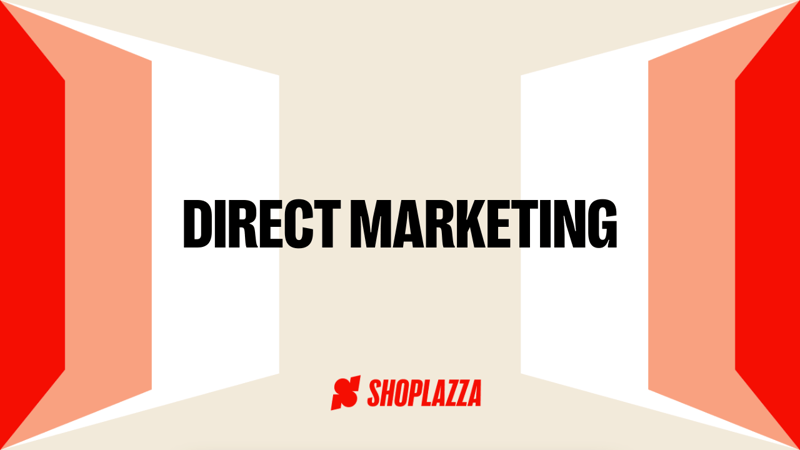
There’s nothing you want more than to reach and engage your target audience effectively. Luckily for you, direct marketing has emerged as a powerful tool that enables businesses to establish personalized connections with potential customers. In this blog post, we will explore the concept of direct marketing, delve into various types and examples, discuss effective strategies, and highlight the immense potential it holds for your business.
What is direct marketing?
Direct marketing is a promotional strategy that involves reaching out to potential customers directly, bypassing intermediaries like retailers or wholesalers. It allows businesses to communicate directly with their target audience through a range of channels, such as email, direct mail, telemarketing, SMS marketing and social media.
The primary goal of direct marketing is to establish a personalized connection and prompt a specific action, such as making a purchase, requesting information or subscribing to a service.
Direct and indirect marketing
Direct marketing and indirect marketing are two distinct approaches that businesses employ to reach and engage their target audience. While both aim to promote products or services, they differ in terms of communication channels, messaging, and overall strategies.
The main distinction between direct marketing and indirect marketing lies in the nature of communication and the level of personalization.
Direct marketing allows for one-to-one communication, delivering highly-targeted messages and offers tailored to each consumer. In contrast, indirect marketing aims for broader reach, often targeting larger audiences without the same level of personalization.
Direct marketing emphasizes immediate response and action, while indirect marketing focuses on creating a lasting brand impression and building relationships over time. With direct marketing, your campaigns can yield quicker results and higher response rates, while indirect marketing strategies are designed for long-term brand building and awareness.
Types of direct marketing
Direct marketing can come in many forms, but here are the most popular ones:
- Direct mail marketing: Direct mail involves sending promotional materials, such as postcards, catalogs, brochures or sales letters, directly to the intended recipient's physical mailbox. It allows your business to deliver targeted messages and offers to a specific demographic, which is pretty much a synonym for personalization.
- Email marketing: Email marketing involves sending targeted messages and promotional offers directly to a recipient's email inbox. This can be an efficient and cost-effective way for your business to reach a large audience while allowing for personalization, segmentation and automation.
- Telemarketing: Telemarketing involves using phone calls to directly engage with potential customers. Whether you hate it or not, it’s an invaluable resource for your business to have real-time conversations, answer questions, address concerns, generate leads and increase sales.
- SMS marketing: SMS marketing utilizes text messages to reach customers directly on their mobile phones. It offers a concise and immediate way to deliver limited-time offers, discounts or important updates, fostering engagement and driving action. It’s also a great tool for direct response marketing, as it can help you reach your audience quickly.
- Social media marketing: Social media platforms provide a direct line of communication between businesses and their target audience. Companies can leverage social media channels to engage with users, share targeted content, run promotions and build customer relationships.
Direct marketing examples
To help you better understand what direct marketing looks like, here are four examples of direct marketing efforts you can invest in:
Catalog marketing
You know all those catalogs that people refer to as junk mail? They work.
Catalogs are a super popular form of direct marketing because they allow customers to visualize products and even the lifestyle attached to them. Companies like IKEA and Williams-Sonoma use catalogs to showcase their products and offer an interactive shopping experience to customers.
Your catalogs can be tailored to specific customer profiles, which can help you boost your online store traffic.

Personalized direct mail
Sending flyers, coupons and brochures to your customer base is another way to go. Direct mail marketing has a higher chance of being noticed and remembered, as it stands out from the digital clutter and offers a less intrusive way of reaching your potential and current customers.
You can use a direct mail campaign to send personalized offers, coupons or promotions to customers based on their purchase history, preferences or demographics.
This tailored approach provides a tangible and physical connection with your audience. Unlike digital marketing channels, direct mail allows for the sensory experience of holding a physical piece, which can leave a lasting impression and create a sense of credibility and trust. And you know what that means: more engagement and conversion.
Email newsletters
More than just a content marketing strategy, email newsletters are an awesome and effective way to provide subscribers with valuable content, product updates and exclusive offers.
Newsletters are a vastly popular form of direct marketing because they can help build customer loyalty, build relationships and drive repeat sales.
Shoplazza also makes the most of direct marketing with a newsletter to our merchants.
Social media influencer marketing
Influencer marketing isn’t just for massive brands that can afford a Kardashian. Companies of all sizes collaborate with influencers on platforms like Instagram or YouTube to promote their products or services directly to their followers.
Influencer marketing is one of the most popular direct marketing methods because influencers’ endorsement can provide a personal touch and authenticity, as well as reach a highly engaged audience.
How to create a profitable direct marketing campaign
Direct marketing campaigns play a pivotal role in enabling businesses to connect with their target audience in a personalized and effective manner. These campaigns provide a direct line of communication that cuts through the noise and allows companies to deliver tailored messages, offers and promotions directly to potential customers.
In this section, we will explore the key elements of a successful direct marketing campaign and discuss strategies to create impactful connections.
1. Define clear objectives
Before launching a direct marketing campaign, it’s crucial to define clear objectives. What do you aim to achieve? Are you looking to drive sales, generate leads, increase brand awareness, or foster customer loyalty?
Clearly outlining your goals will help shape your direct marketing strategy and ensure that all your efforts align with the desired outcomes.
2. Know your target audience
Understanding your target audience is the cornerstone of any successful direct marketing campaign.
Take the time to do some market research and analyze your audience’s demographics, behaviors preferences and pain points. This information will enable you to create personalized messages that resonate with your audience and drive engagement.
3. Develop compelling offers
To capture the attention of your target audience, it’s essential to develop compelling offers that provide value and incentivize action.
Whether it’s a discount, exclusive access, free trial or limited-time promotion, the offer should be clear, enticing and relevant to the recipient’s needs or desires. A strong offer can significantly increase the response rate and improve conversion rates.
4. Craft persuasive messaging
The messaging of your direct marketing campaign should be persuasive, concise and tailored to resonate with your specific audience.
In your marketing message, focus on addressing their pain points, showcasing the benefits of your product or service and highlighting what sets you apart from competitors. Use compelling language, storytelling techniques and testimonials to create an emotional connection and drive action.
For a Mother’s Day marketing campaign, the athleisure brand lululemon sent a very compelling offer that appeals to people who want to treat their mothers with nice leggings that “match their energy”:

5. Personalize the experience
Your customers don’t want to be just a drop in the ocean; they want to feel special and appreciated. This is where personalization comes in.
Leverage the data you have on your target audience to personalize the messages, offers and recommendations you deliver. Address consumers by their name, reference their past purchases or interactions, and provide relevant content that speaks directly to their needs.
The more personalized the experience, the higher the chances of engagement and conversion.
If the York University, for instance, knows that a person is interested in digital marketing, they'll send them course recommendations via email—and they’ll even mention their name in the subject line!
6. Multi-channel approach
Today's consumers interact with brands across multiple channels. To ensure maximum reach and engagement, it’s crucial to adopt a multi-channel approach in your direct marketing campaigns.
If you have the budget for it, consider using a combination of email marketing, direct mail, social media, SMS and other relevant channels to connect with your audience at various touchpoints. Consistency in messaging and branding across channels will help reinforce your campaign’s impact.
7. Test, track and optimize
Testing and tracking the performance of your direct marketing campaigns is vital to their success. Implement tracking mechanisms to measure key metrics such as open rates, click-through rates, conversion rates and ROI.
A/B testing can help identify the most effective elements of your campaign, whether it's the subject line, call-to-action, offer or design.
Continuously optimize your campaigns based on the insights gained from testing to improve results and maximize your marketing efforts.
Monitor and follow-up
Once your direct marketing campaign is in motion, don’t forget to monitor its progress and promptly follow up on leads or inquiries.
Stay responsive to customer queries, provide additional information or support and nurture leads to conversion. Building a positive customer experience throughout the campaign and beyond can help strengthen customer relationships and drive long-term loyalty.
Create effective direct marketing strategies
When you invest in direct marketing, your business has the opportunity to connect with its target audience in a personalized and direct manner, resulting in higher engagement and improved conversion rates. By leveraging various direct marketing channels and employing effective strategies, you can build much stronger customer relationships, drive sales and achieve your marketing objectives.
There are many types of direct marketing out there, and you might feel like you have to do it all at once. Well, don’t.
Before you make any large investment, take a moment to assess if and which direct marketing efforts fit within your marketing budget. Once you begin to see some results, you can always go back and reevaluate your strategy to see if there are other forms of direct marketing you should invest in.
Now that you’ve got the basic info you need to ensure your direct marketing strategy reaches its full potential, it’s time to create your first direct marketing campaign! Good luck!




